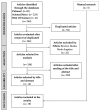Antimicrobial Efficacy of Chemomechanical Carie Removal Agents-A Systematic Integrative Review
- PMID: 39200199
- PMCID: PMC11351369
- DOI: 10.3390/biomedicines12081735
Antimicrobial Efficacy of Chemomechanical Carie Removal Agents-A Systematic Integrative Review
Abstract
Background: Dental caries is the most common oral disease in the world. When treatable, the drilling method continues to be used. This technique has its disadvantages because it is invasive and nonspecific. Chemomechanical carious tissue removal agents (CCRAs) such as Carisolv™ or Papacarie® are non-invasive products that allow for the specific elimination of infected dentin. On the other hand, cariogenic bacteria are largely responsible for the initiation and development of lesions.
Objectives: The aim is to analyze whether CCRAs have a relevant antimicrobial effect on cariogenic bacteria.
Methods: A bibliographic search strategy was carried out in online databases using PRISMA 2020. The evaluation of the antibacterial efficacy of CCRAs was carried out through the analysis of the reduction in CFUs of cariogenic bacteria, and the presence of bacterial deposits, TVC, SVC and LVC by comparison with conventional drilling methods.
Results: The results showed that the percentage of reduction in TVC, SVC and LVC for each agent is mostly high, but not significantly different from mechanical methods. The best results were found with CCRAs when compared to polymeric drills. The results also showed that there is a lack of methodological standardization.
Conclusions: CCRAs have been shown to have a relevant antimicrobial effect on cariogenic bacteria; however, more studies need to be carried out using standardized methodologies.
Keywords: antimicrobial efficacy; chemomechanical caries removal system; dental caries; minimal invasive.
Conflict of interest statement
The authors declare no conflicts of interest.
Figures
References
-
- World Health Organization (WHO) Global Oral Health Status Report: Towards Universal Health Coverage for Oral Health by 2030. WHO; Geneva, Switzerland: 2022.
-
- Catunda R.Q., Altabtbaei K., Flores-Mir C., Febbraio M. Pre-Treatment Oral Microbiome Analysis and Salivary Stephan Curve Kinetics in White Spot Lesion Development in Orthodontic Patients Wearing Fixed Appliances. A Pilot Study. BMC Oral Health. 2023;23:239. doi: 10.1186/s12903-023-02917-z. - DOI - PMC - PubMed
Publication types
LinkOut - more resources
Full Text Sources



